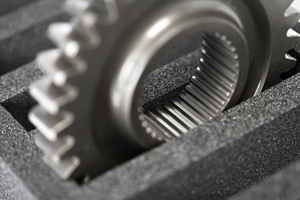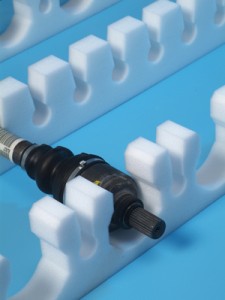 In a market returning to strength, protective packaging can save cost, reduce damage, prevent downtime, and maintain good customer satisfaction.
In a market returning to strength, protective packaging can save cost, reduce damage, prevent downtime, and maintain good customer satisfaction.
The UK automotive sector is having its moment, and helping to lead the recovery of Europe’s car market. According to the Society of Motor Manufacturers & Traders (SMMT), the UK market recorded its 31st month of growth in September. While this may partly be driven by a strengthening economy, maximising effectiveness and efficiency throughout the supply chain is also helping that growth.
Over the years, one aspect of the supply chain that has been a concern is the issue of damage to parts or vehicles while in transit, often due to a lack of proper packaging. However, OEMs are increasingly using protective packaging to help minimise the level of damage, and their operational costs.
The issue of packaging can easily be overlooked by manufacturers – who are often more concerned with production line efficiency – but it is used initially during the transport of parts, and then extensively in the aftersales market when parts are replaced, repaired and serviced. Packaging is also used for the delivery of machine tool parts and production line equipment. The majority of these parts will be fragile, and have high value. Damage can occur during storage, handling and transport, even down to the last few feet. This can include anything from surface scratches, to vibration disrupting electronic circuits or bearing alignment, or even parts breaking after being dropped.
The logistics industry is so reliant on just-in-time (JIT) and lean six sigma approaches, but the cost of damage during the supply chain can easily escalate beyond the original value of a part, and lead to hours or days of unscheduled downtime. Damaged parts can cause severe delays throughout the entire supply chain, which means missed deadlines and low levels of customer satisfaction, something which manufacturers naturally want to avoid.

Protective packaging can certainly help to reduce damage to parts and equipment, but the huge range of part size, shape, fragility and weight can makes things difficult. It needs to be fit for purpose, and able to protect even the most fragile part. An off-the-shelf solution just won’t work.
For the part being transported, protective packaging needs to be bespoke, which can often mean expensive outlays and lengthy consultations, but continuing advances in protective packaging technology means this doesn’t always have to be the case.
‘Packaging Value Analysis’, a design process developed by Sealed Air, analyses the size, weight and shape of a part, and the impacts that could occur throughout the supply chain. Stresses and impacts are evaluated in line with the fragility of an object, and how its performance may be affected. This can involve anything from drop tests, to vibration tests. From here, a packaging material that will optimise the process is selected, focusing on minimising packaging volume, but maximising the protection, to allow more parts to be shipped, and also reduce costs. [sam_ad id=6 codes='true']
Packaging material needs to be compatible with the parts it is protecting, including maintaining high-quality surface finishes. Parts made from chrome or other abrasion-sensitive finishes will benefit from a soft-touch solution that will hold parts in place, but with minimal friction. For lighter parts, paper packaging or inflatable air cushions can be effective, while heavier and complex parts may require foam-in-place packaging, which can mould to a part’s irregular shape and can be re-used in reverse logistics.
To establish an effective protective packaging process, collaboration and communication is key. The basic steps OEMs can take to stabilise packaged parts can make a significant difference in reducing damage and cost. However, protective packaging goes beyond cost reduction, helping to avoid unscheduled downtime and lengthy delays, especially in the aftercare and repairs markets where consumers are becoming increasingly demanding. For a market returning to strength, it can prove invaluable.
Lester Barratt is international key account manager at Sealed Air, a global packaging company



































